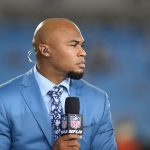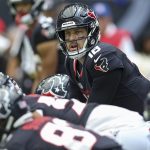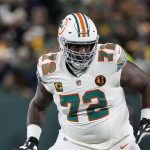I feel pretty confident declaring, at least at this point in time, if the Blackhawks were indeed able to find a viable trade partner for Brent Seabrook, they wouldn’t hesitate for even microsecond to emancipate themselves from the regressing defenseman’s albatross and monumentally troublesome contract.
As the title of this piece reminds us, unfortunately, unearthing such a feasible scenario will be no easy task for Stan Bowman and the Blackhawks as Seabrook’s contract ranks among the worst in all of hockey.
To put it bluntly, the 32-year old is a slightly-above-average, second-pairing NHL defenseman at this point in his career who is being paid as an elite blue-liner in his prime. Not only is Seabrook the highest paid defenseman on the Blackhawks, he’s the 11th highest paid blue-liner in all all of hockey – right there alongside names like Erik Karlsson, Alex Pietrangelo, Drew Doughty, Kris Letang, and Victor Hedman.
Needless to say, his output as a player hasn’t exactly been proportional to the $6,875,000 awarded to him annually by the penniless Blackhawks. There’s countless analytics nerds out there that can reinforce this reality for you just in case your eyes ceased to work each time he was on the ice the past two seasons.
His regression is not his fault, though. Rather than pointing fingers at Seabrook, your more logical target should be the team that rewarded a gargantuan superstar’s contract team’s normally reserve for 22-25-year old’s to a physically-past-his-prime then 30-year old defenseman with more mileage on his body than a 92-year old triathlete. If you don’t have the gall to criticize the Blackhawks front office, then blame Seabrook’s body for abiding by the basic rules of human anatomy.
Oh, and did I mention Seabrook is under non-voidable contract until 2023-2024 when he’ll be at the tender age of 38-years old and likely relying heavily on a wheel-barrow for mobility by that time?
Can you see where this might get complicated? After what I described above I’m sure – aside from playing out his past achievements over-and-over in your head – you’re just about at that point where you’re asking yourself “who would even think of taking on his contract?”
Well, that’s precisely what I’ll be spending the next couple of paragraphs attempting to decipher for myself. Not to go all Neil DeGrasse Tyson on your asses, but let’s just say the stars would have to align. Let’s go through the checklist of obstacles.
- Cap space
This is really a difficult time to project teams’ cap space seeing that we’re still weeks away from the NHL draft, expansion draft and, most significantly, free agency. No one knows who’s going to sign where and what trades will be made and who will be claimed etc. With this info behind us, regardless of what transpires during free agency or either draft, there aren’t many teams out there with the space accommodate nearly $7 million in cap hits over the course of 7 more seasons. And the few teams that can accommodate this number are, in traveling equivalence, the Flint, Michigan’s and Newark, New Jersey’s of the NHL. Not the most desirable of destinations in Layman’s terms. There’s really only one team that makes sense at this point, but I’ll get to them later.
2. Even if you could afford him, why would you want him?
Hypothetically, there are a handful of teams out there that can afford Seabrook, but then the question arises, why the hell would they invest that type of the capital into a player who has regressed substantially just one season into an 8-year deal? And before his past achievements start racing again inside your head, remember GM’s are investing in what you can do, not what you’ve done. It doesn’t work that way. Being an essential piece in 3 Cup runs years prior holds no bearing in what might happen in the future. Plus, if you’re the guy in charge of building and managing rosters for a young, inexpensive and up-and-coming franchise, wouldn’t you want to allocate your money elsewhere, into safer resources? Perhaps into younger players that pose no longevity concerns and have an overall higher ceiling than a 32-year old with degenerating legs?
3. Why would Seabrook want to go anywhere?
Say by some miracle – like perhaps Stan Bowman split the pieces of his soul into fragments – sort of like how Voldemort did with his Horcruxes and was able to gambit these remaining pieces that have yet to be bartered into a deal – Bowman indeed was able to coerce a partner into taking Seabrook’s contract, what’s to stop the blue-liner from nixing the trade? You see, Seabrook possesses a full no movement clause until the 2021-2022 season. What this mandates is that Seabrook can basically refuse any sort of trade involving him. You’re living comfortably in the same, wonderful city you’ve been in for a large percentage of your adult life with a wife and child playing for perhaps the league’s most popular and recently successful franchises among all your teammates and friends who have essentially grown to become family now; Do you know what doesn’t sound very appealing? Having (to quote the great Mike Commodore) to “pack your shit” and move to Colorado or Arizona or Vancouver or whatever other bottom-of-the-barrel, basement franchise might want to trade for you.
4. The Vancouver Canucks
This franchise in it’s current state is a damn dumpster fire. You’re more likely to see a mega earthquake rock the city of Vancouver before you see a competitive Canucks team take the ice. While bad news for hockey fans and, uh, all people in the Pacific Northwest alike, this is fantastic news for a Blackhawks team in need of a landfill to unload their expensive but otherwise useless garbage into. Longevity and suckiness is the key here. You see, as I just mentioned, Vancouver is going to be a very cheap and very bad team for many years to come as they continue to embark on their cost-effective rebuild that centers primarily around the load-up of prospects and young talent. Like any team restocking their arsenal with young, cost-effective talent, the Canucks will need to load up on bad contracts simply to reach the cap floor, especially after Daniel and Henrik Sedin’s combined $14 million comes off the books at the conclusion of next season. While it isn’t typical for franchises to take on long-term deadweight money, hometown guy Brent Seabrook could be just the contract Vancouver needs to balance the scale. Perhaps he’d be willing to waive his NMC and look past the years of bad hockey ahead of him in order to ride into the sunset in his hometown.
5. Collateral
Needless to say, if by some miracle the stars do align and a team decides to inherit Seabrook’s deadweight contract, you better believe they wont be taking it for free. Like I said, the ideal candidate will be a team in the midst of a long-term rebuild. In order for a team to take on Seabrook’s contract, a smart GM would demand collateral or a “I scratched your back, you scratch mine” scenario. A good, recent example would be Carolina’s absorption of Bryan Bickell’s contract that came with the collateral demand of Teuvo Teravainen as insurance. So if Seabrook is moved, don’t be surprised to see a first round pick or top prospect (please god not Debrincat) go the other way with him.












